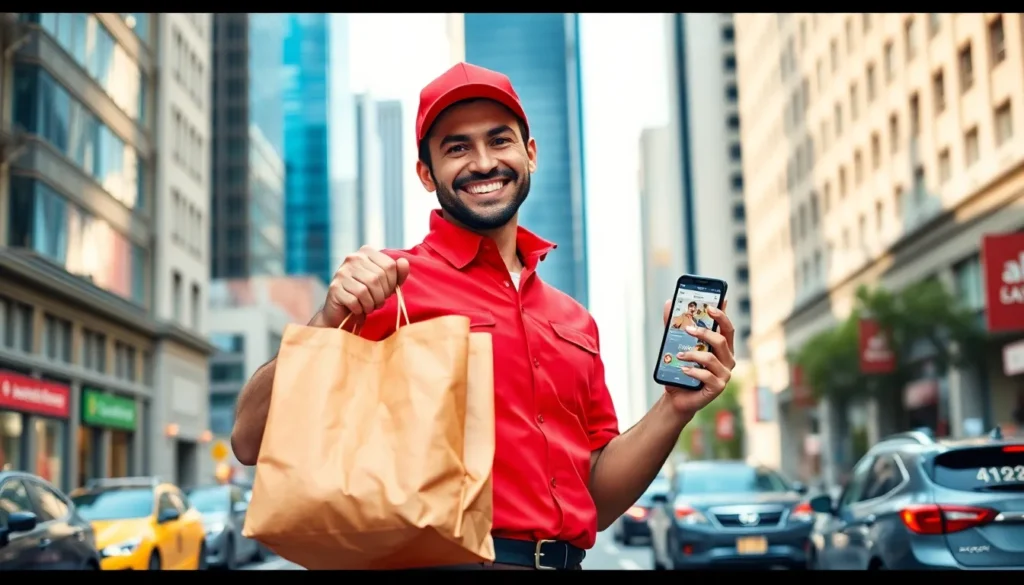Table of Contents
ToggleIn a world where delivery drivers are the unsung heroes of our takeout cravings, the question on everyone’s mind is: which delivery service pays the most? With the rise of gig economy jobs, drivers are cashing in on their wheels while dodging the dreaded “sorry we’re closed” sign. But not all delivery apps are created equal; some are rolling in the dough while others are barely scraping by.
Overview Of Delivery Services
Delivery services vary significantly in pay structures across the gig economy. Each service has its unique compensation model, which affects drivers’ earnings. Some platforms charge higher fees to customers, allowing for better pay for drivers.
Uber Eats generally offers competitive base pay, alongside tips that can increase earnings substantially. Grubhub, on the other hand, provides earnings that can fluctuate based on order volume and the distance of deliveries.
DoorDash stands out with its guaranteed earnings model, ensuring drivers receive a minimum amount for each delivery. Postmates operates similarly to Uber Eats, allowing for tips to boost overall income.
Additionally, various bonuses and incentives are common among delivery services. Many companies implement promotions during peak hours, which can significantly enhance earnings. For instance, DoorDash often runs “Peak Pay” during busy times, incentivizing drivers to accept more deliveries.
Local factors also influence earnings significantly. Areas with higher demand and fewer drivers often lead to better pay rates. Drivers in urban centers typically experience increased opportunities and higher earnings due to population density.
Understanding the differences among delivery services helps drivers make informed decisions. They can choose platforms that align with their earnings goals. Evaluating the overall compensation structure and additional bonuses aids in maximizing potential income.
Factors Influencing Pay Rates

Delivery service pay rates depend on several key factors that shape drivers’ earnings potential. Understanding these components helps drivers select the right platform for maximizing income.
Base Pay
Base pay provides a foundational earning structure for delivery drivers. Uber Eats typically offers competitive starting pay, which varies based on location and time of day. Grubhub features a different model, where base pay fluctuates depending on order volume and delivery distance. DoorDash guarantees a minimum payment per order, ensuring drivers receive a set amount regardless of the order specifics. Local market conditions also affect these base amounts, as urban areas often generate higher base pay due to increased demand. By analyzing these pay structures, drivers can identify which service aligns best with their financial goals.
Tips and Bonuses
Earnings for drivers significantly increase through tips and bonuses. Tips represent a crucial component of overall pay, with platforms like Uber Eats and Postmates allowing customers to tip freely, impacting drivers’ income substantially. DoorDash offers incentives, such as “Peak Pay” during busy times, allowing drivers to earn extra income when demand surges. Other bonuses may include referral rewards, which add even more financial benefits. Drivers in busy markets typically experience higher tipping levels and more frequent bonuses. These opportunities can create considerable variation in earnings, emphasizing the importance of maximizing interaction with customers to enhance profitability.
Comparison Of Popular Delivery Services
Delivery services vary significantly in their compensation models. Understanding these differences helps drivers make informed decisions about which platform suits their income needs best.
Service A
Uber Eats provides a competitive compensation structure. Drivers earn a base pay that typically ranges from $1 to $10 per delivery, depending on distance and location. Tips also enhance overall earnings; customers can tip through the app, with many choosing to do so. Drivers can expect bonuses for promotions or busy hours, which further boosts income. Additionally, urban areas tend to offer more opportunities due to higher order volumes.
Service B
Grubhub operates on a different pay model. Base pay fluctuates based on factors like order distance and demand. Average earnings often lie between $3 and $8 per delivery. Like Uber Eats, same-day tips contribute to overall pay, giving drivers a chance to increase their income. Grubhub offers a transparency feature, allowing drivers to see how much they’ll earn before accepting deliveries. Promotions and incentives help improve earnings during peak times, though drivers report income variability based on market demand.
Service C
DoorDash employs a guaranteed earnings model, ensuring that drivers receive a minimum payout per delivery, generally starting around $2.50. Earnings can rise significantly with tips, as customers often leave gratuities for excellent service. During busy hours, DoorDash introduces “Peak Pay” incentives, which can raise earnings by an extra $1 to $3 per delivery. While the minimum payout can appeal to many drivers, local demand influences overall income potential. With favorable urban areas, DoorDash can provide consistent earning opportunities for drivers.
Regional Variations In Pay
Pay rates for delivery drivers differ significantly based on location. Urban areas typically offer higher compensation due to increased demand for delivery services. Drivers in cities often benefit from higher tips because of the larger customer base and greater volume of orders.
Regional differences can also arise from the cost of living. Areas with elevated living costs may lead to delivery platforms adjusting their pay structures accordingly. Drivers in these regions might find themselves earning more to offset living expenses.
Base pay also varies from one delivery service to another. For example, Uber Eats generally presents competitive base pay, while Grubhub has a range of pay that fluctuates between $3 and $8. DoorDash guarantees a minimum payment, often around $2.50 per delivery, which can enhance earnings during peak times.
In addition to base pay, tips and incentives play a crucial role. Local tipping customs influence how much drivers can earn. For instance, urban customers tend to tip more generously, increasing potential income.
Analyzing regional demand and competition among drivers provides critical insights. Local regulations may impact operational hours and service areas, affecting overall earning potential. Platforms that adjust dynamically to demand, like DoorDash with its “Peak Pay,” can offer additional financial benefits during busy periods.
Understanding these regional variations in pay empowers drivers to maximize their earnings based on location. With knowledge of local market conditions, drivers can choose the services that align best with their financial goals.
Choosing the right delivery service can significantly impact a driver’s earnings. Each platform offers unique compensation models that cater to different preferences and market conditions. Drivers must consider factors like base pay tips and bonuses when deciding where to work.
By understanding the nuances of each service and regional pay variations drivers can maximize their income potential. Urban areas often provide better opportunities due to higher demand and tipping customs. Ultimately selecting a platform that aligns with individual financial goals can lead to a more rewarding experience in the gig economy.




